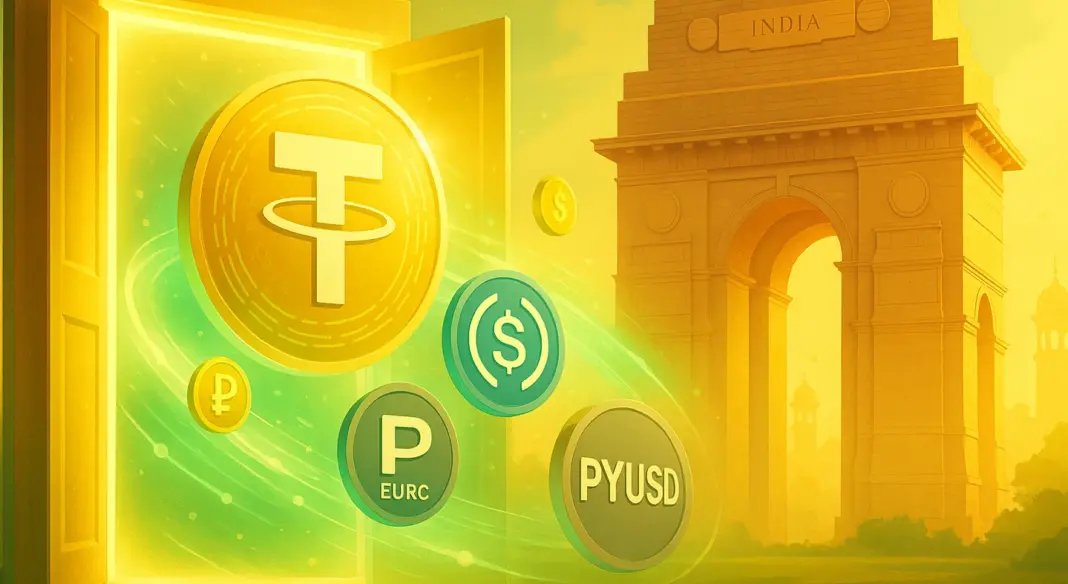Digital money is running the show now, and stablecoins, the crypto cousins tied tightly to good old traditional assets like the US dollar, are stealing the spotlight.
These slick coins promise lightning-fast, border-hop-free transactions, catching the eyes of investors and businesses worldwide.
The question is, will India finally join the stablecoin party or keep holding its nose?
Stay ahead in the crypto world – follow us on X for the latest updates, insights, and trends!🚀
No nation can insulate itself from systematic change
Finance Minister Nirmala Sitharaman just dropped a hint that India might be warming up to stablecoins, no matter how much the old guard grumbles.
Watch Live: Smt @nsitharaman's inaugural address at the Kautilya Economic Conclave 2025 in New Delhi. #KEC2025 @FinMinIndia @IEGResearch https://t.co/ThjF1xrKEv
— Nirmala Sitharaman Office (@nsitharamanoffc) October 3, 2025
Speaking at the Kautilya Economic Conclave, she didn’t sugarcoat it, the world of money is morphing fast, and stablecoins are at the heart of this change.
Her message? Either you adapt to this bold new world or you get left behind, waving your cash like a relic of the past.
Sitharaman declared the progress won’t wait, sounding like a futuristic Gandalf warning India to keep up or get burned.
“No nation can insulate itself from systematic change. Whether we welcome these shifts or not, we must prepare to engage with them.”
Global rules on crypto
Why the change of heart? India’s always tiptoed around cryptocurrencies with the caution of a cat in a room full of rocking chairs.
The government has feared systemic risks, like letting a wild beast loose in the banking system.
Reuters spilled the beans, and shared that India isn’t ready for full-on crypto regulation yet.
Instead, it plans a soft touch, sneaking partial oversight into the mix while watching global moves carefully.
Remember back in 2021 when India almost banned private crypto assets but then backed off?
Since then, it’s been more of a watch-and-wait dance, especially during its 2023 G20 leadership gig when it pushed for global rules on crypto.
A planned 2024 discussion paper on regulations got shelved because, well, everyone’s still figuring out what stablecoins really mean for governments.
A blueprint for handling stablecoins
On the other hand, the Reserve Bank of India keeps waving red flags about crypto risks.
But India’s market watchdog, SEBI, is playing nice, showing signs it might actually regulate crypto assets instead of fearing them.
India’s crypto hesitation stands out because other nations are cannonballing into stablecoin regulations.
The U.S. already passed the GENIUS Act, a neat blueprint for handling stablecoins.
Industry experts also highlighted that Hong Kong rolled out a stablecoin licensing system, and Japan’s JPYC startup is gearing up to launch the first yen-backed stablecoin sometime soon.
So India’s at a crossroads, cling to old fears, or dive into this brave new stablecoin ocean where money swims fast, borderless, and digital.
Based on Sitharaman’s words, it sounds like the country is deciding to at least test the waters, because in the global financial party, there’s no polite way to decline the dance anymore.
Disclosure:This article does not contain investment advice or recommendations. Every investment and trading move involves risk, and readers should conduct their own research when making a decision.
Kriptoworld.com accepts no liability for any errors in the articles or for any financial loss resulting from incorrect information.
Cryptocurrency and Web3 expert, founder of Kriptoworld
LinkedIn | X (Twitter) | More articles
With years of experience covering the blockchain space, András delivers insightful reporting on DeFi, tokenization, altcoins, and crypto regulations shaping the digital economy.
📅 Published: October 5, 2025 • 🕓 Last updated: October 5, 2025
✉️ Contact: [email protected]


